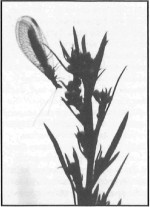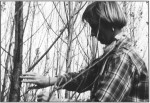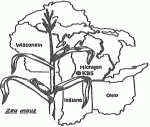Much has been written in recent years about the expected long-term sustainability of modern row- crop (e.g., corn-soybean) cropping systems. Concerns about the short- and long-term economic viability of these systems, as well as the environmental costs of chemical- intensive management, is changing the tenor if not yet the substance of basic agricultural field research in the United States. It has become clear to agronomists attempting to address the issue of sustainability that at its heart the issue is an ecological one, and that at present we have a truncated understanding of basic ecological relationships in our most economically important cropping systems.
Research underway as part of the LTER program at W.K. Kellogg Biological Station (KBS) is geared toward addressing basic questions related to ecological interactions in modern row-crop farming systems. Efforts are also aimed understanding the impact of these systems on the larger environment.
Past Research Efforts
Agricultural productivity integrates the interactions of three major functional groups in cropped communities: microbes that regulate nutrient availability, insects and other consumers (including pathogens) that regulate net primary productivity (NPP) loss to herbivory and disease, and non-crop plant competitors that affect crop access to resources. LTER research at KBS generally focuses on interactions among these three groups and on the effects of these interactions on NPP (especially crop productivity) and biogeochemical fluxes.
To address these foci we have assembled a group of over 20 senior investigators representing both the agronomic and ecological sciences. Much of our effort is focused on a 120-ha field site divided into 1-ha treatment plots, which correspond to eight different cropping systems and plant communities. These include conventionally farmed corn-soybean rotations, organic-based corn- soybean-wheat rotations, perennial (alfalfa and Poplar) systems, and unmanaged old-field communities. We also examine watershed-level processes in the nearby Augusta Creek watershed. In 199 1-92 the following new projects were initiated by KBS LTER scientists.
Differential Responses to Soil Resource Heterogeneity
If different annual and perennial plant species respond differentially to patchy distributions of soil resources, then knowledge of these differences may allow us to better predict plant success in cropped and other early successional communities. In this project Kay Gross and Kurt Pregitzer, with primary support from the National Science Foundation (NSF) Ecology Program, are comparing in situ soil spatial heterogeneity to the abilities of successional dominants to respond to this heterogeneity. Species- specific responses are being evaluated in greenhouse minirhizotron experiments in which root responses to artificial nutrient patches are evaluated. Preliminary experiments suggest that perennial species respond more quickly to patches of enhanced nutrients than annuals, but that annuals can rapidly exploit a large soil volume.
Trace Gas Fluxes
There is at present a massive imbalance in the global nitrogen trace gas budget: only about 60 percent of global nitrous oxide sources are identified, which leaves a net atmospheric flux of about 6 Tg N per year from unknown sources. Agricultural contributions to the missing flux may be underestimated: conventional sampling programs can miss many of the highly dynamic flux events in
disturbed soils, and much of the effect of agriculture may be expressed at uncropped sites in the downstream portion of the watershed. With primary support from the U.S. Department of Energy, LTER researchers Phil Robertson, Keith Paustian, and Mike Klug are using automated sampling chambers to provide fine temporal resolution of in situ fluxes from a variety of cropping systems on the main LTER site. With partial funding from the Mellon Foundation, Lars Hedin is also examining water-borne fluxes along hydrologic flow paths in an adjacent mixed-agriculture watershed.
Belowground Carbon Flow
To better understand the influence of contemporaneous (same-season) carbon inputs on soil-plant carbon cycling, William Horwath, Eldor Paul, and Kurt Pregitzer have dual-labeled a set of Poplars ‘4C and 15N to track carbon and nitrogen into various plant components (sugars, starch, proteins, lipids, and lignocellulose residues in particular), and then to soil microorganisms and soil organic matter. Root exudates and turnover may have strong immediate effects on soil microbial biomass, which may in turn affect seasonal community-wide nutrient retention. This work is funded by the National Science Foundation.
Landscape-Level Coccinellid Movement
Insect populations in cropping systems can be very sensitive to disturbances associated with crop management; this is especially true for predaceous populations that might in general be beneficial to the crop. Local landscape heterogeneity may affect survival and recolonization rates by these predators by providing temporary refugia, overwintering sites, or other critical habitats. In this project, Stuart Gage and Karim Maredia, with NSF and U.S. Department of Agriculture (USDA) support, are addressing questions related to landscape structure, organization, and disturbance frequency as predictors of Coccinellidae species dynamics in row crop systems.
Spatially-Explicit Modeling
Biogeochemical models of nitrogen and carbon fluxes in cropping systems generally ignore small-scale spatial variability, though much of this variability is imposed by planting patterns associated with the crop itself. To improve the efficiency of existing models and to evaluate the importance of crop spacing for nutrient turnover and retention, Keith Paustian and Phil Robertson use N15- tagged crop litter to track the cross-row variability of important N-cycle processes in three major tillage systems. Primary funding is from the USDA National Research Initiative Competitive Grants Program.
For further information:
Phillip Robertson, KBS, Michigan State University, Hickory Corners, MI 49060, 616-671-2267, pRobertson@lternet.Washington.edu.

 Enlarge this image
Enlarge this image

